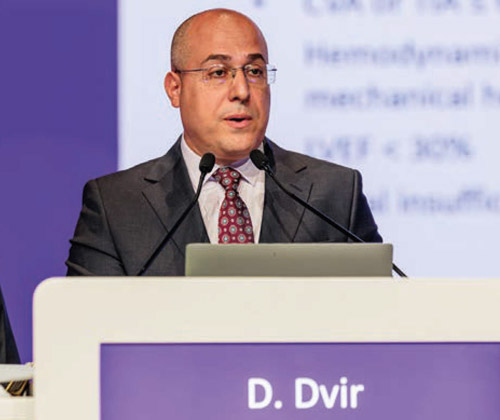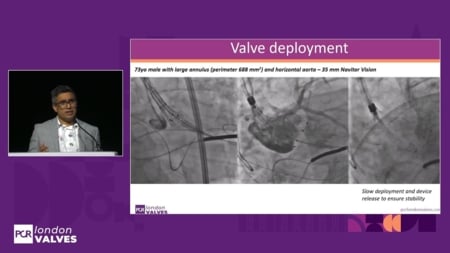16 May 2024
Pivotal study on the ShortCut transcatheter aortic valve leaflet splitting device
Promising results on the first-ever dedicated leaflet splitting device were presented in EuroPCR 2024 TAVI Hotline session.
Coronary obstruction is a major concern in patients undergoing TAVI for degenerated bioprostheses (valve-in-valve [ViV]) and is associated with a 30-day mortality rate of around 50%.1 While several transcatheter techniques to lacerate bioprosthetic valve leaflets prior to TAVI placement (such as BASILICA) have been described, they are considered complex, time - and resource consuming, and are associated with an unpredictable success rate, especially for cases at risk for double coronary obstruction.
Didier Tchetche (Clinique Pasteur - Toulouse, France), Principal Investigator of a trial with the new dedicated leaflet splitting ShortCut device, explains why such a device is particularly relevant for today's TAVI patient: "Lifetime management for patients with aortic stenosis is an increasingly important consideration as the use of bioprosthetic valves is rising in younger patients. During a ViV procedure, the leaflets of the prior valve are displaced towards the coronary ostia, potentially resulting in an obstruction of coronary blood flow. A device such as ShortCut is necessary to facilitate the treatment of patients requiring multiple valve therapies throughout their lifetime."
During the ShortCut procedure, the catheter is introduced through the femoral artery and advanced to the aortic valve over a pre-shaped guidewire. Once the device is properly aligned at the annular level, the positioning arm is exposed and rotated towards the targeted leaflet. Having achieved the desired position, a splitting element is activated, penetrating the bottom of the leaflet from the ventricular side. If the splitting of a second leaflet is required, the positioning arm can be rotated towards the targeted leaflet and the procedure repeated.
As presented yesterday by Principal Investigator, Danny Dvir (Sha'are Zedek - Jerusalem, Israel), the pivotal investigational device exemption (IDE) ShortCut trial involved 60 patients - including 70% females - who presented for a ViV TAVI procedure for an approved indication and who were at risk for TAVI-induced coronary artery ostium obstruction based on anatomical criteria.
The patient population, described as being "very representative of contemporary daily practice," had a median age of 77 years, included patients presenting with failed surgical and TAVI bioprostheses, with 63% of patients at risk for single coronary obstruction and 37% at risk for double coronary obstruction.

Leaflet splitting with ShortCut met the primary safety endpoints of procedure-related mortality and stroke assessed within 7 days, with no procedural mortality and one stroke (1.7%).
In addition, the primary efficacy endpoint of successful leaflet splitting, confirmed by transoesophageal echocardiography (TOE), was achieved in 100% of patients.
"Leaflet split was achieved efficiently with a single attempt in all cases despite being performed by first-time users, which is not the case with the complex BASILICA technique," explains Professor Tchetche. "Furthermore, ShortCut does not prolong the procedural time to any great extent as seen with the BASILICA technique. If needed, coronary access can still be achieved after the ShortCut procedure, adding to its beneficial safety profile."
Professor Dvir concludes, "First results from the pivotal trial are highly promising - this easy-to-use device acts as an adjunct to TAVI and addresses an important unmet clinical need for the increasing numbers of patients who will likely require multiple valve interventions and for whom there are currently no straightforward solutions. Given that the device is so simple and safe, why wouldn't I use it for many procedures, even just to improve post-TAVI coronary access? We can predict that leaflet modification will grow dramatically in upcoming years, hopefully as a simple add-on step for our procedures, which can probably be done without changing the setup - under conscious sedation, without TOE and only rarely, with a neuroprotection device. Our next step is to gather longer-term outcomes data and acquire more experience with the device in larger cohorts of patients."
- Ribeiro HB, et al. Eur Heart J. 2018;39:687-695.




